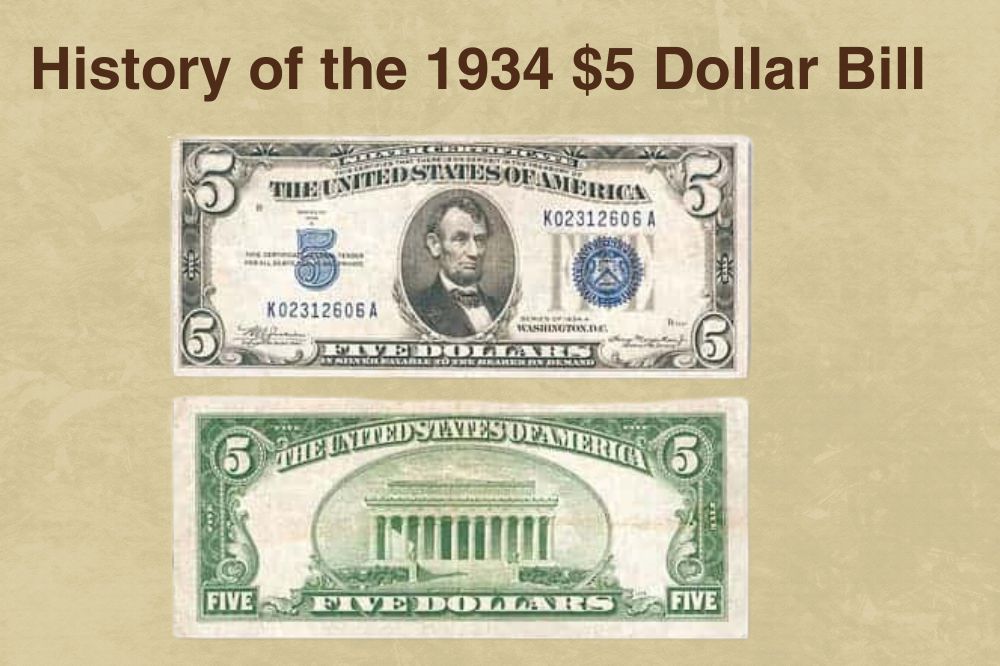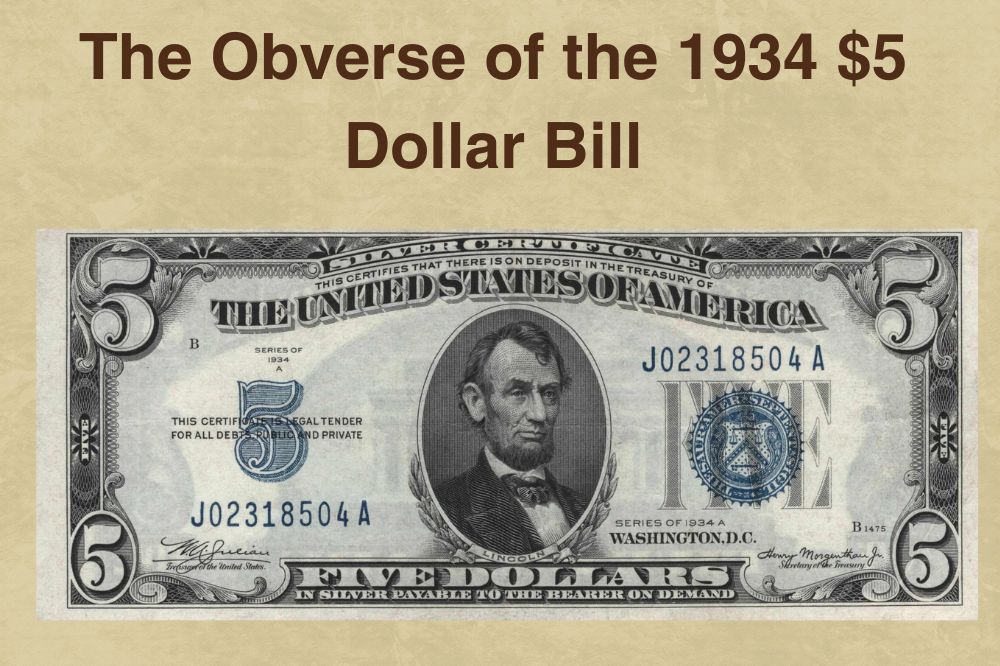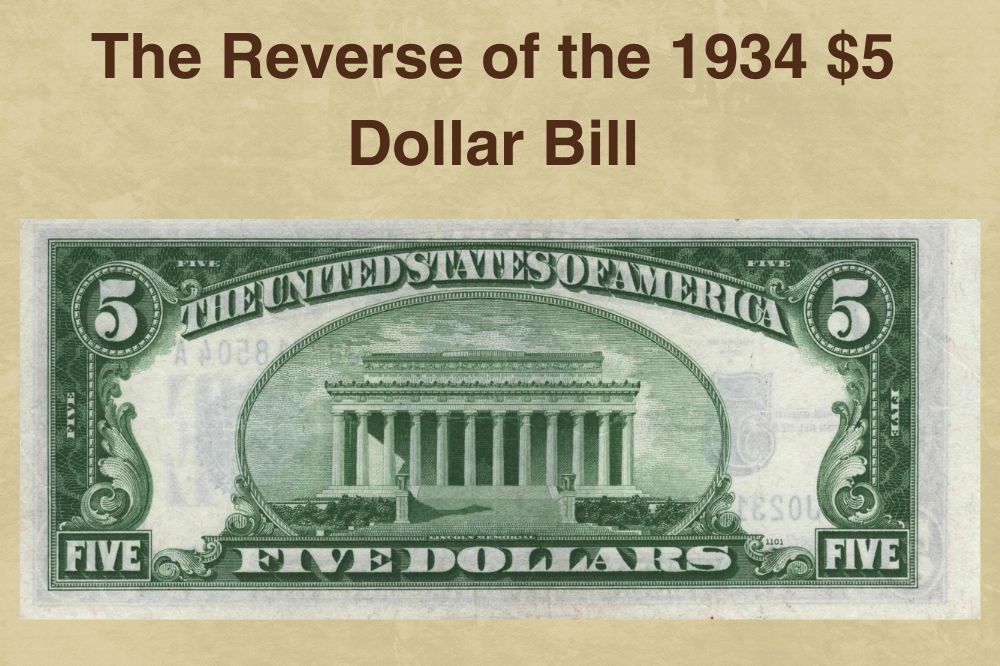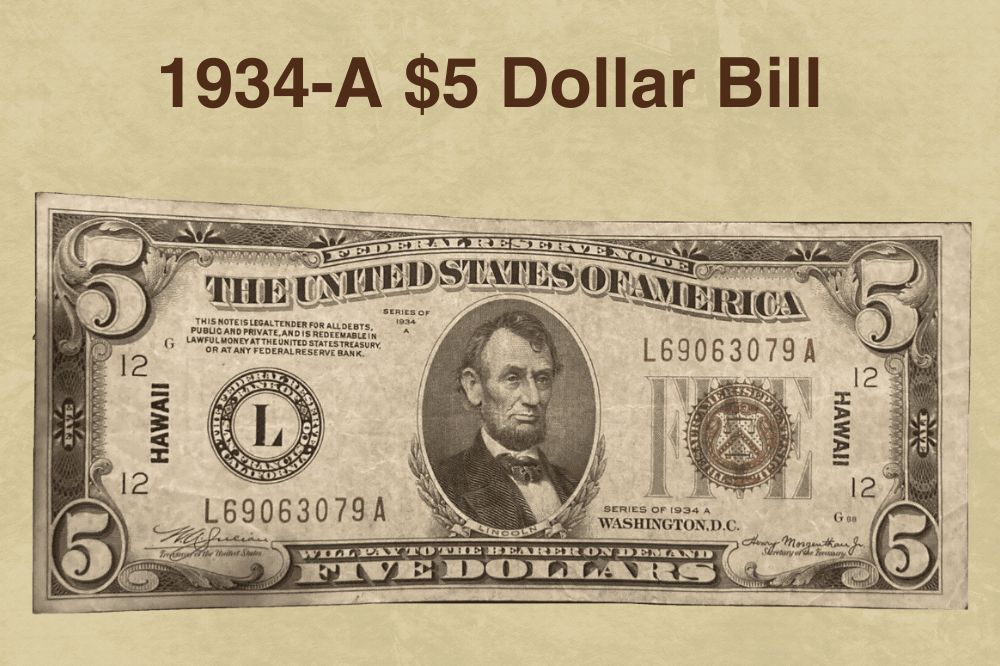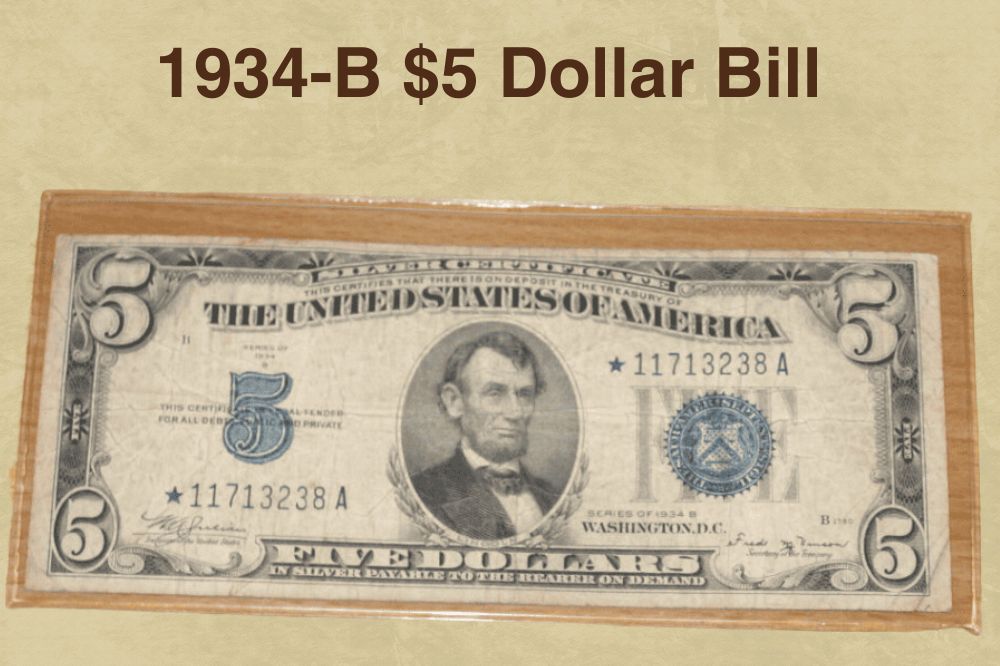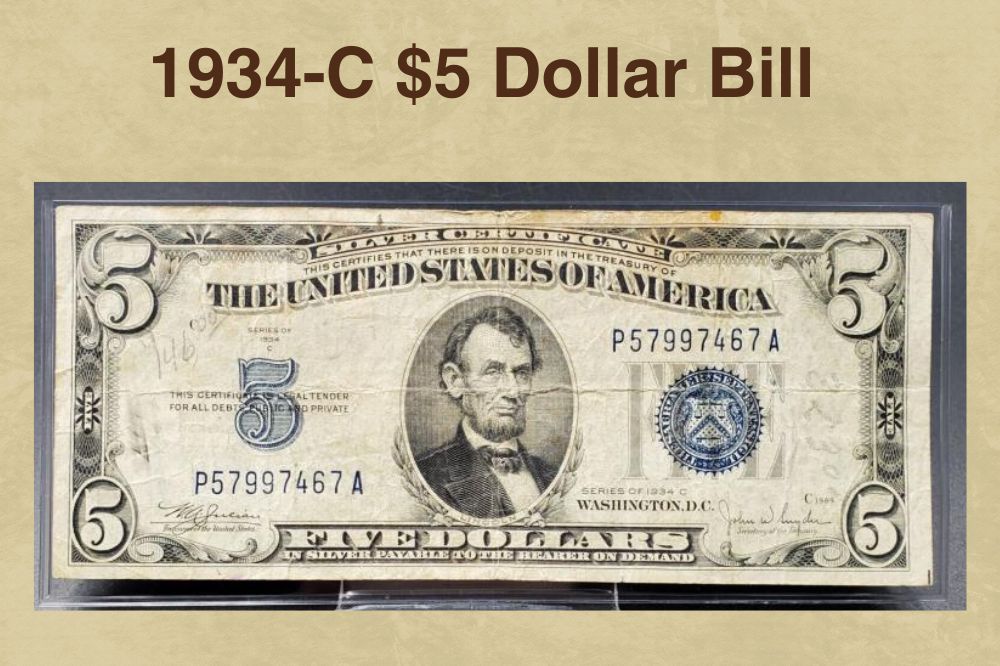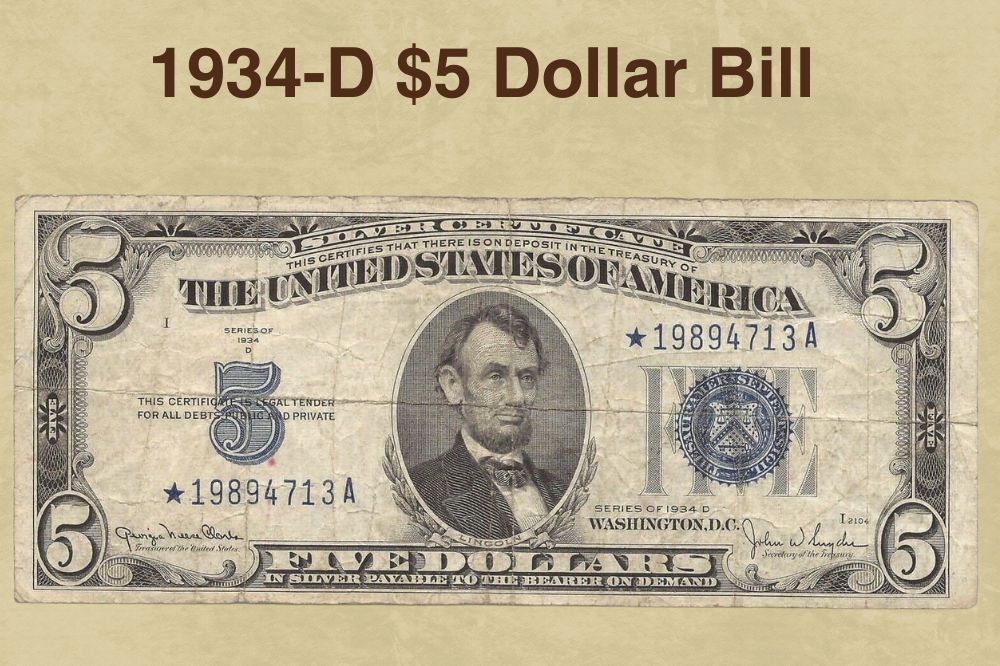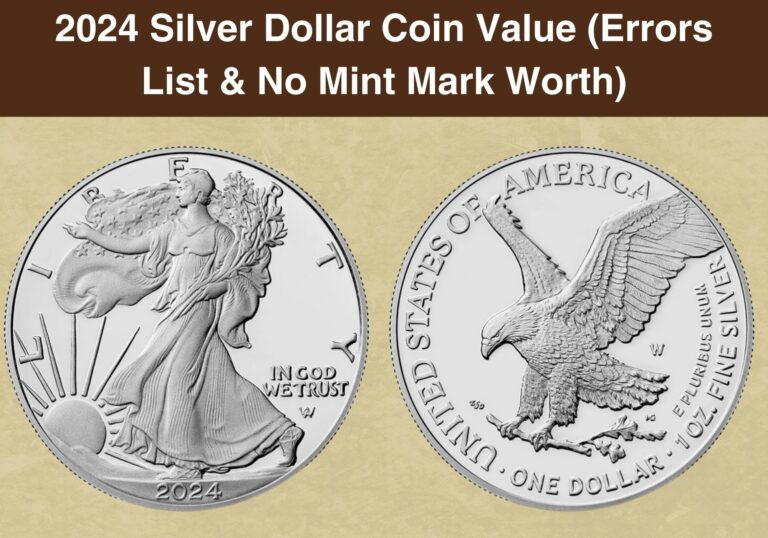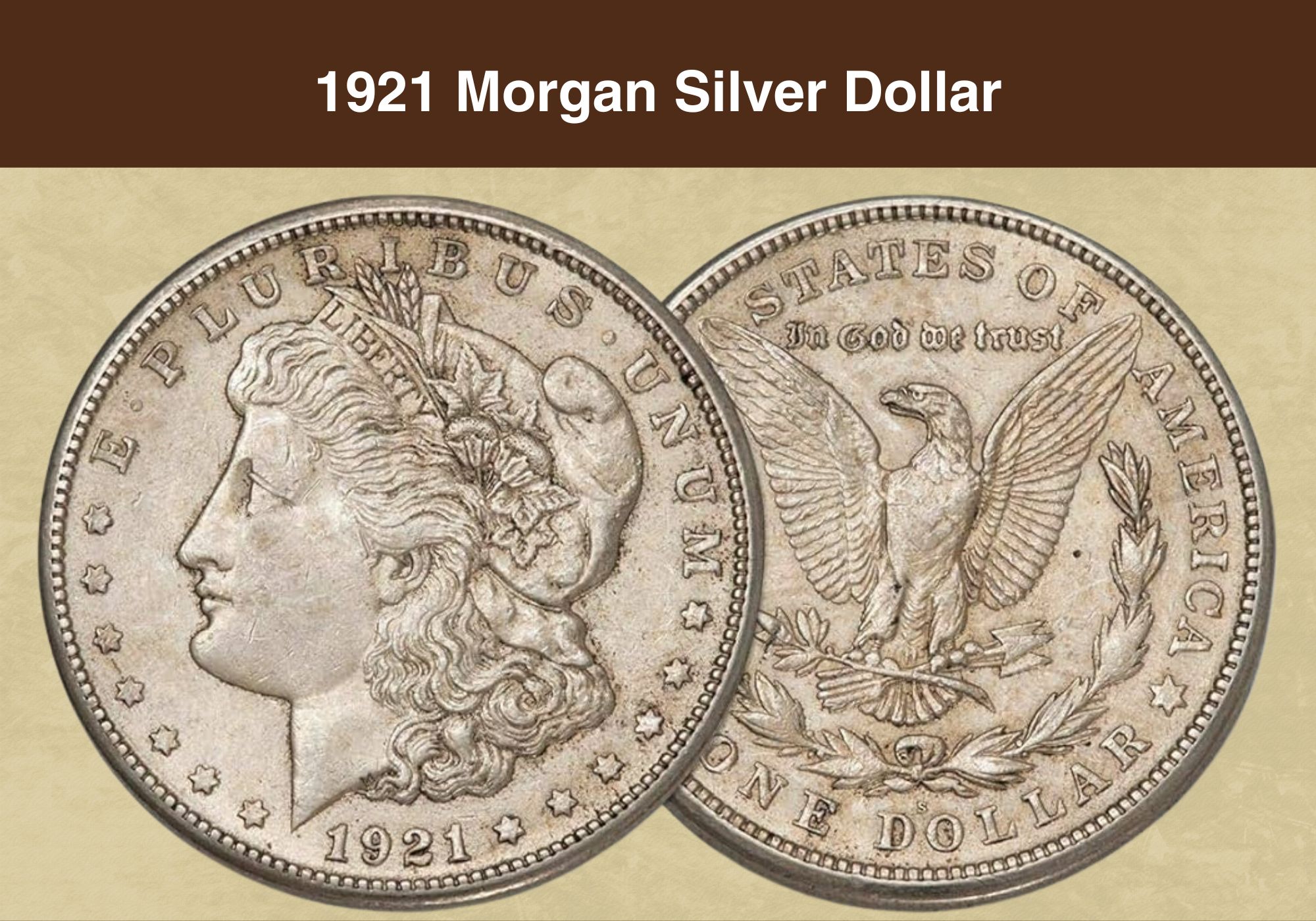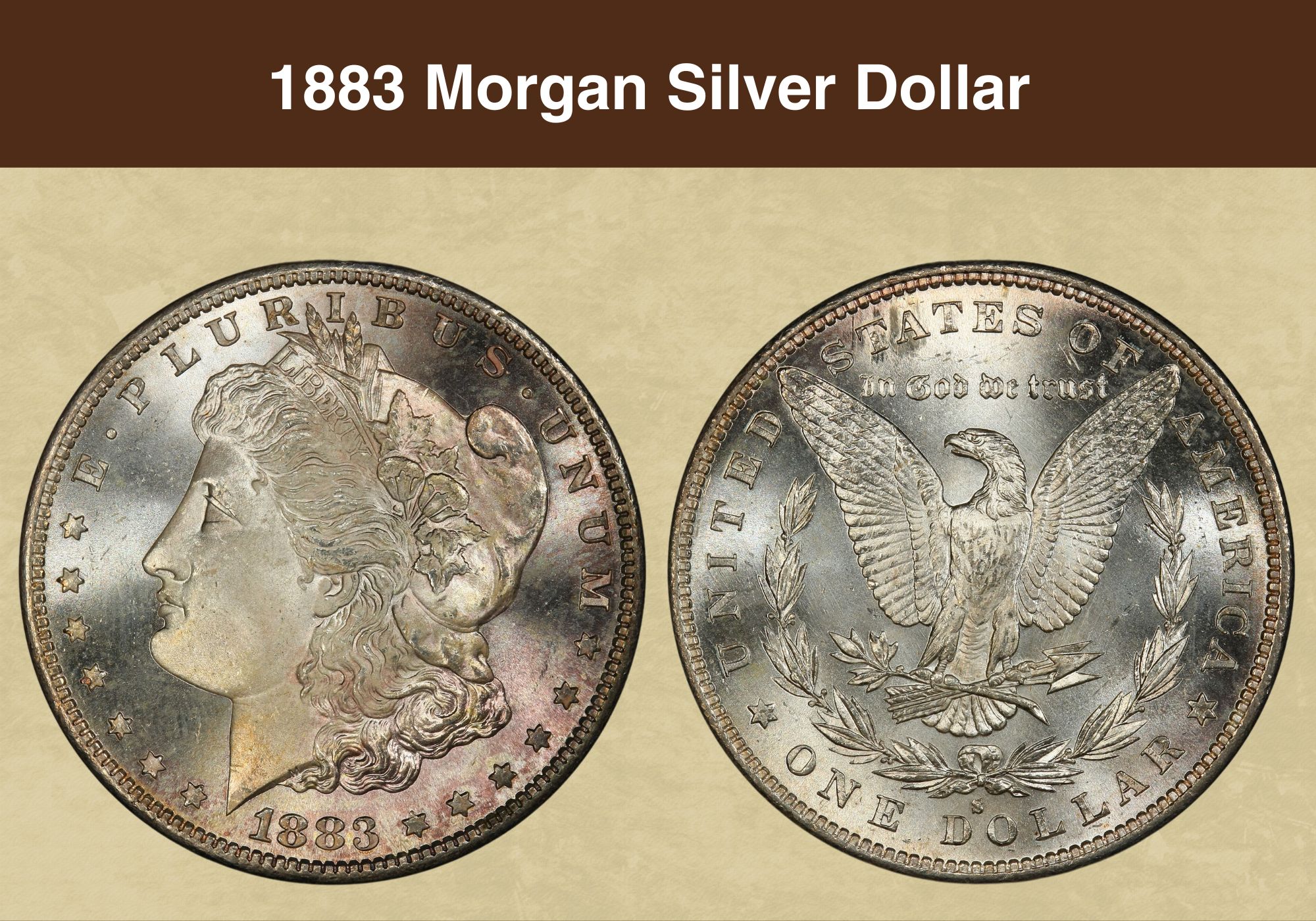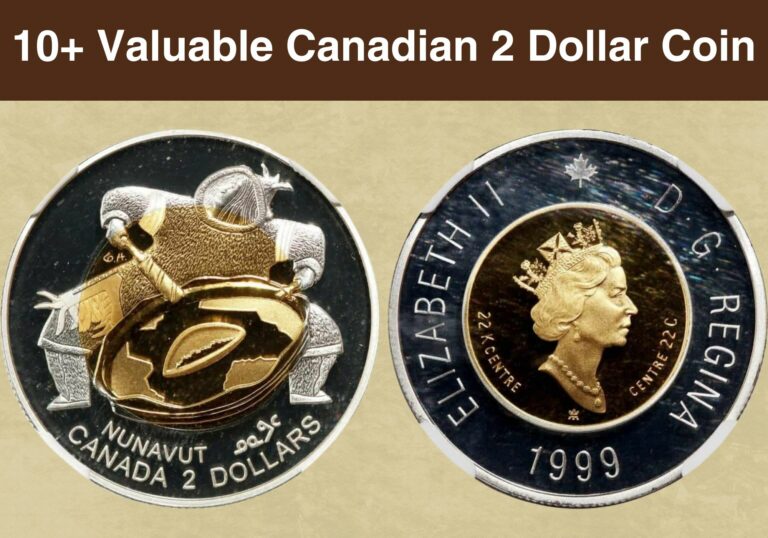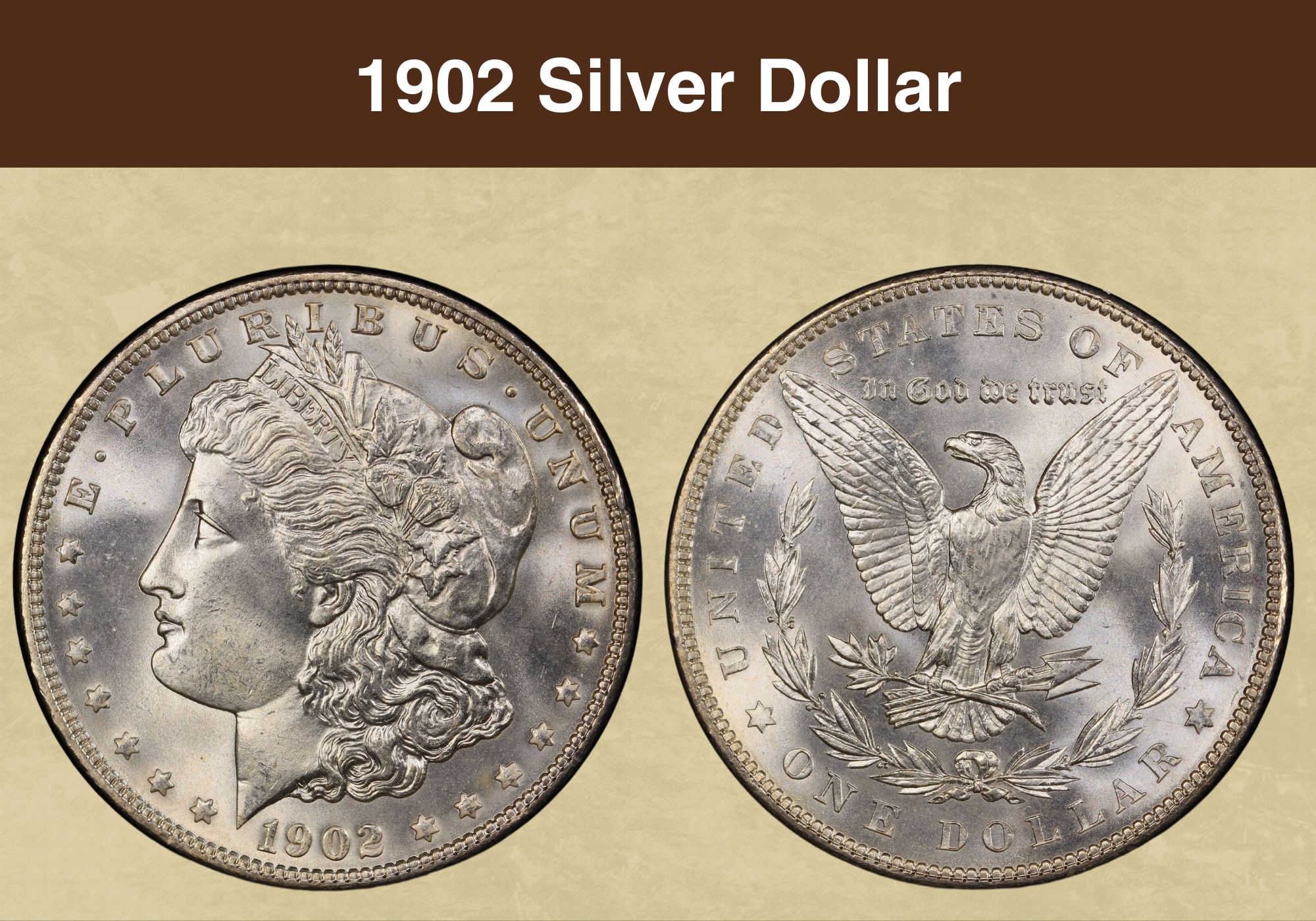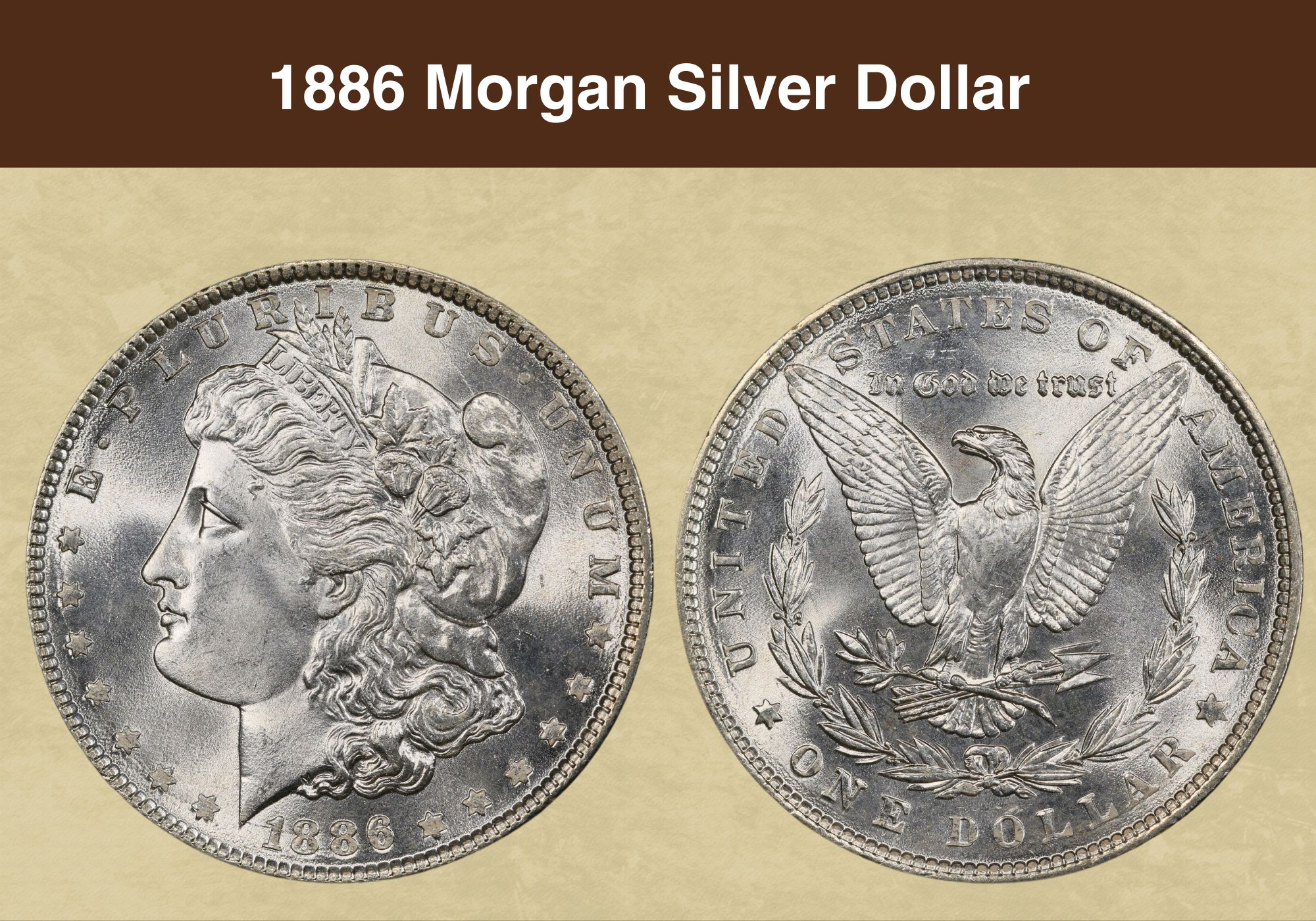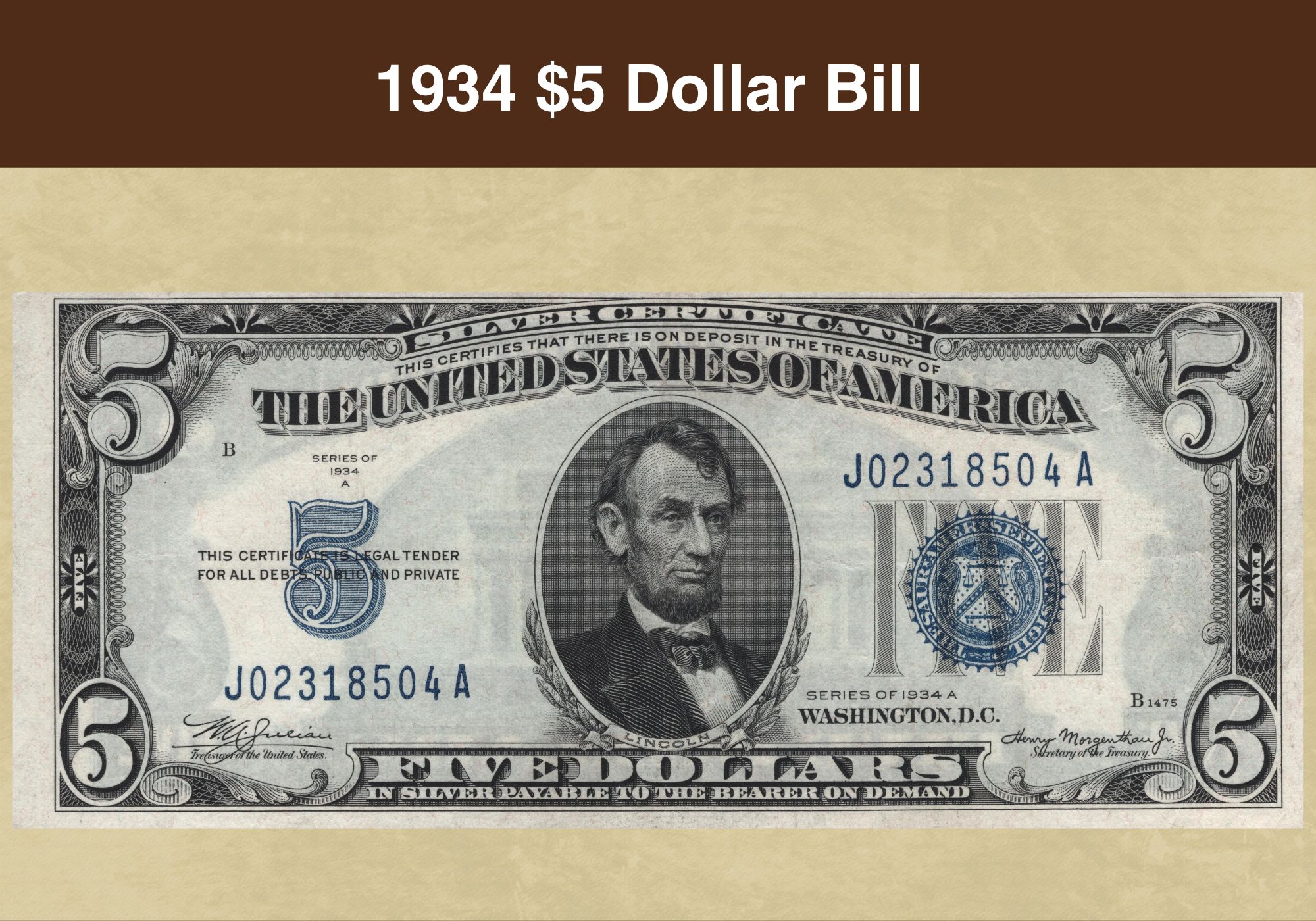
Coin Value Contents Table
The earliest dollar bills in existence were known as Silver Certificates. They ranged from $1 to $1,000 and served as portable substitutes for silver ingots. Soon, they were much more popular than their bulky metal equivalents, including gold coins. So let’s explore the 1934 $5 Dollar Bill Value, digging into its history, legacy, economic impact, and cultural significance.
1934 $5 Dollar Bill Value Chart |
|||||
| Series | Signatories | Seal Colour | Fine F 12 | Extremely/Extra Fine EF/XF 40 | Uncirculated Mint State 60 and Above |
| 1934 $5 Silver Certificate | Julian and Morgenthau Jr. | Blue | $6 | $8 | $35+ |
| 1934 $5 Federal Reserve Note | Julian and Morgenthau Jr. | Green | $7 | $12 | $50+ |
| 1934 $5 Hawaii Overprint | Julian and Morgenthau Jr. | Brown | $25 | $80 | $550 |
| 1934-A $5 Silver Certificate | Julian and Morgenthau Jr. | Blue | $6 | $8 | $20+ |
| 1934-A $5 Federal Reserve Note | Julian and Morgenthau Jr. | Green | $7 | $12 | $50+ |
| 1934-A $5 Hawaii Overprint | Julian and Morgenthau Jr. | Brown | $25 | $90 | $550+ |
| 1934-A $5 North Africa and Europe | Julian and Morgenthau Jr. | Yellow | $20 | $60 | $250+ |
| 1934-B $5 Silver Certificate | Julian and Vinson | Blue | $8 | $12 | $45+ |
| 1934-B $5 Federal Reserve Note | Julian and Vinson | Green | $7 | $12 | $50+ |
| 1934-C $5 Silver Certificate | Julian and Snyder | Blue | $6 | $9 | $25+ |
| 1934-C $5 Federal Reserve Note | Julian and Snyder | Green | $7 | $12 | $50+ |
| 1934-D $5 Silver Certificate | Clark and Snyder | Blue | $6 | $8 | $18+ |
| 1934-D $5 Federal Reserve Note | Clark and Snyder | Green | $7 | $12 | $50+ |
History of the 1934 $5 Dollar Bill
In the old days, the precious metal in a coin matched its dollar value. This meant silver coins were bulky and cumbersome while gold coins were tiny and easy to lose. Most people used Gold and Silver Certificates instead. You could keep your specie metals at the bank and get this paper money instead, exchanging it for hard currency whenever you needed your coins.
Gold Certificates were used from 1865 to 1933. Silver Certificates showed up a little later in 1878. While they were issued until 1964, they survived until 1968, eventually transitioning into circulating dollar bills. In their final year – 1968 – you could take your Silver Certificate to the bank and get raw silver bullion as opposed to the silver dollar coins from earlier years.
But even today, you can redeem silver certificates for American paper money. The first ones were larger in size (7 and 3/8 inches by 3 and 1/8 inches, or 187mm by 79mm). Later ones printed from 1928 to 1964 were physically smaller, the same size as paper currency today. So the 1934 $5 bill was 6.14” by 2.61” aka 156mm by 66mm. The bimetallic standard mattered.
Back then, you could exchange a fixed amount of silver for a fixed amount of gold and vice versa. But the 1850s Gold Rush dropped gold prices and spiked silver ones so the 1873 Coinage Act killed the bimetallic standard, allowing silver pricing to be dictated by market forces. This led to a silver crash since you could only redeem Silver Certificates for up to $5.
Revamping the Value of Silver
Five years later, the Bland-Allison Act of 1878 boosted silver coinage for a while. A hundred or so years later, the silver spike of the 1960s took silver out of hard currency for good. This led to the cupronickel coins we use today. But let’s get back to banknotes. In 1934, the US Mint added a significant sentence to the front of Silver Certificates that deeply affected trade.
Before then, you could only exchange Silver Certificates for Silver Dollar Coins at the bank, so banks had to maintain large batches of silver dollars in their vaults. But starting in 1934, they changed a few words, allowing people to get raw silver instead of struck dollars. It freed the US Mint from making Silver Dollars, which were expensive and rarely circulated anyway.
It also paved the way for the routine use of banknotes in daily transactions. From a collector’s perspective, it’s one of the things that makes the 1934 $5 Dollar Bill valuable. Interestingly, $5 bills dated 1934 weren’t necessarily printed in 1934. The mint date – or rather the series year – simply confirmed the date when the design of that banknote was officially approved.
Anytime the banknote changed its design – usually by adding or removing a signature to show changes in signatories – they added a letter under the year. This is how 1934 $5 Bills ended up with five variations from 1934 to 1934-D. Also, while coins are made using dies, notes are printed from printing plates. The plate series might be 1934, 1935, 1953, then 1957.
The Meaning of Letters on Bank Notes
The signatories we’re referring to are the Secretary of the US Treasury, the Register of the US Treasury, and sometimes an Assistant Treasurer of the United States. When the person in these roles changed, their successor would have to sign a fresh series of banknotes as part of the transition. This meant a new letter was added to the banknote, for example, 1934-C $5.
You might find a 1934 $5 Bill made in 1942, or a 1935 $5 Bill made in 1963. The series year has nothing to do with timing. It’s all about the design. Also, usually, blue treasury seals were for Silver Certificates, yellow seals were Gold Certificates and green seals indicated Federal Reserve Bank Notes. But during the war, we didn’t want enemies spending any of our money.
So in 1942, they printed certain notes with a brown seal e.g. Hawaii Overprint Notes in June. They also made yellow seal notes in November 1942. These were used in Africa and Europe. The idea was if these territories fell to foreign powers, the US could demonetize brown and yellow seals, meaning the invaders couldn’t use them as legal tender for daily transactions.
Another key feature is the Star Note, marked with an asterisk next to the serial number. It shows that a banknote was damaged in the press, so its replacement got the identical serial number with a star instead of one letter. Bank notes also have a Friedberg Number or Fr. They were listed by Robert Friedberg in his 1953 book, Paper Money for the United States.
Features of the 1934 $5 Dollar Bill
Just like coins, the heads side of a banknote is called its obverse, the tails side is its reverse, the images or portraits are devices, the words are legends or mottos, and the background of the banknote is the field. Bank notes are printed on 75% cotton and 25% linen to lengthen their lifespans. This ‘paper’ is made by the Crane Paper Company with red and blue fibers.
The Obverse of the 1934 $5 Dollar Bill
It shows Abraham Lincoln with his name underneath the device. On his left is the numeral 5, with the series year above, the serial number below, and the legal tender across the number. Sometimes the 5 is replaced by an encircled District Number or Letter. This order is reversed on the right, with Five written in word form, the serial number above, and the series year below.
The color seal sits over the Word Five on the right. Above Lincoln is The United States of America and below him is the legend Five Dollars in Silver Redeemable to the Bearer. The top says Silver Certificate or Federal Note and the deposit clause. The two signatories are on the lower inner corners. The Federal Reserve Branch and plate numbers are also cornered.
The Reverse of the 1934 $5 Dollar Bill
It shows the Lincoln Memorial Building with its name below it. The top of the note says United States of America. The bottom says Five Dollars followed by the plate number. The lower corners have Five in word form. The upper corners have 5 and Five as numbers and words. The left and right margins have the word Five. These details are printed in green ink.
Other Features of the 1934 $5 Dollar Bill
As we said before, these notes are 25% linen and 75% cotton. They measure 6.14” by 2.61” with black ink on the obverse and green ink on the reverse. The seal, obverse serial numbers, and the number 5 on the left of Lincoln are blue. To identify the printing plate number, check for the face plate digits on the lower right obverse and the back plate on the lower right reverse.
1934 $5 Dollar Bill Value Guides
As we said earlier, the 1934 $5 Dollar Bill had five versions with various Friedberg Numbers. They each represent a different pair of signatures. The first series has no assigned Block Letter while the others have Block Letters A to D. Each series includes $5 bills with different seal colors, ranging from yellow to brown, so let’s look at the individual values of these $5.
1934 $5 Dollar Bill Value
The 1934 $5 Dollar Bill was signed by Treasury Secretary Henry Morgenthau Jr. and his Treasury Register William A. Julian. This banknote exists in blue, green, and brown seals. It’s not an especially expensive coin in its flawless form. A PMG Gem Uncirculated EPQ 67 1934 $5 Blue Seal Silver Certificate was $600 in March 2023. What about Federal Notes?
Some varieties have a yellow-green or pale green seal, and their Friedberg Number is 1955-G. That slight color flaw gives them an extra premium and a 1934 $5 Federal Reserve Note sold for $456 in April 2022. It was graded PMG Gem Uncirculated EPQ 66. A Star Note in Fr. 1956-Lm* Choice Uncirculated EPQ 63 sold a little higher at $576 on that same day.
Meanwhile, a brown seal 1934 $5 Hawaii Emergency War Note was About Uncirculated 58 EPQ. With errors, this coin can sell for thousands of dollars. But a flawless version sold for $384 in March 2022. The Friedberg Number for this Brown Seal Federal Reserve Note is Fr. 2301, and its muled form goes anywhere from $900 for a Very Fine 20 to over $50,000 EPQ.
1934-A $5 Dollar Bill Value
When the 1934-A $5 was redesigned, Henry Morgenthau Jr. was still the Secretary of the Treasury and William A. Julian was still his Register. The note has blue, green, brown, and yellow seals for Silver Certificates, Federal Reserve Notes, Hawaii Emergency Notes, and North Africa + Europe Emergency Notes respectively. One 1934-A Brown Seal was $456.
The note was graded Gem 65 PPQ and it was sold in April 2019. Without errors, its Friedberg Number is Fr. 2302, but a Star Note has more value even in low grades. A PMG Choice Fine 20 sold for $5,060 in September 2009. The Silver Certificate Blue Seal is Fr. 1651 and a Gem Uncirculated 66 EPQ sold for $4,700. PCGS has graded 50 flawless notes and 10 Star Notes.
1934-B $5 Dollar Bill Value
William A. Julian was still in office for the 1934-B $5 but his new boss was Fred M. Vinson. Once you’re familiar with Friedberg Numbers, you can tell a lot about a coin at a glance. The 1934-B is an Fr. 1652. Error versions are Fr. 1652* while mules with a different reverse are Fr. 1652m* coins. Even a low-grade 1934-B $5 Mule in Fine 30 managed to sell for $7,800.
1934-C $5 Dollar Bill Value
The Register of the Treasury is sometimes known as the Treasurer, and William A. Julian served through three redesigns from the 1934 $5 to the 1934-C $5. But once again, he had a new superior – John Wesley Snyder. The 1934-C $5 Blue Seal Silver Certificates have Wide and Narrow versions. One Fr. 1653 Narrow PMG Choice Uncirculated 63 EPQ was $11,162.
Meanwhile, the Green Seal Federal Reserve version of this note is Fr. 1959. These Friedberg Numbers often have additional letters to note small varieties within the category. Just as an example, a 1934 $5 Green Seal Federal Reserve Mule aka Fr. 1959-KW* PMG AU 53 EPQ sold for $1,800 in August 2018. It was graded. A Blue 69 PPQ was $5,040 in April 2019.
1934-D $5 Dollar Bill Value
By the time the 1934-D $5 showed up, Julian had finally bowed out and was replaced by Georgia Neese Clark, the first woman to hold this position, and every US Treasurer after her has been female. In her twenties and early thirties (1921 to 1931), she was an actress who made $500 a week. But when talkies took over, she got a lowly job at her dad’s bank in 1935.
She had studied economics at university, and when her father died in 1937, she took over his business interests and kept things moving. Her role in role politics led to her appointment as the Treasurer in 1949 for Secretary John Wesley Snyder. An uncut sheet with a dozen 1934-D $5 Silver Certificates was graded EPQ 65 Gem Uncirculated. It was $1,440 in March 2019.
1934 $5 Dollar Bill Grading
Bank notes use a similar number system to coins, ranging from 1 to 70. But grades from 65 to 70 have the additional initials PPQ, meaning Premium Paper Quality for PCGS (Professional Coin Grading Service), or EPQ for Exceptional Paper Quality at NGC Numismatic Guaranty Company). Below is a summary. The numbers may sometimes differ for PCGS and NGC.
- 1 – Poor
- 2 – Fair
- 3 – About Good
- 4 to 6 (NGC) or 4 to 8 (PCGS) – Good
- 10 – Very Good
- 12 – Fine
- 15 – Choice Fine
- 20 to 30 – Very Fine
- 35 – Choice Very Fine
- 40 – Extremely Fine
- 45 – Choice Extremely Fine
- 50 to 55 – About Uncirculated
- 58 – Choice About Uncirculated
- 60 to 62 – Uncirculated
- 63 to 64 – Choice Uncirculated
- 65 to 66 PPQ/EPQ – Gem Uncirculated
- 67 to 69 PPQ/EPQ – Superb Gem Uncirculated
- 70 PPQ/EPQ – Supreme Gem Uncirculated
- PMG – Paper Money Guaranty for Exceptional Eye Appeal
- Details (PCGS) or Net (NGC)– Authentic Coin With Damage
1934 $5 Dollar Bill Errors
On all forms of currency, a mint error can raise the price of your specimen. But it’s harder to find errors on bank notes than on coins because the BEP (Bureau of Engraving and Printing) is quick to catch them and replace them with star notes. Some examples of errors that do slip out include double denominations, misalignment, fold-overs, obstructions, and inversions.
1934 $5 Dollar Bill Hawaii Mule Star Note
This is one of the most expensive coin errors of this series. It was a brown-seal Hawaii note dictated by the war. But in the rush to print it, the note was muled with a $10 reverse so it’s a double denomination note. In March 2023, an EPQ 66 Gem Uncirculated sold for $52,800.
1934-D $5 Dollar Bill Double Denomination Error
Even without a star, muled notes can be worth a lot. This example is a Double Denomination Green Seal graded Gem Uncirculated 65 EPQ. It has a $5 Obverse and a $10 Reverse and it sold for more than $25,000 on 8th January 2020. A 64 Choice Uncirculated is cheaper at $2,300.
1934 $5 Dollar Bill FAQ
What is the Most Valuable $5 Bill?
From 1934, the Most Valuable $5 Bill is the Hawaii Emergency Note Fr. 2301m*. This $5 Bill has a Brown Seal, a $5 Front, and a $10 Back. In March 2023, it sold for more than $50,000.

